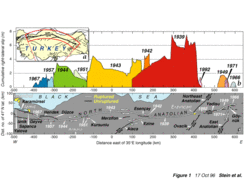Remotely triggered earthquakes
| Part of a series on |
| Earthquakes |
|---|
| Types |
|
|
| Causes |
| Characteristics |
|
|
| Measurement |
| Prediction |
| Other topics |
|
Earth Sciences Portal Category • Related topics |
It is postulated that large earthquakes can have an influence outside of the immediate aftershock zone, and remotely trigger earthquakes at considerable distance.[1] The further one gets from the initiating earthquake in both space and time, the more controversial is the association.
The physics involved in actually triggering an earthquake is complex. Most earthquake-generating zones are in a state of being close to failure. If such a zone were to be left completely alone, it would generate significant earthquakes spontaneously. Remote earthquakes, however, are in a position to disturb this critical state, either by shifting the stresses statically, or by dynamic change caused by passing seismic waves.

The first type of triggering may be due to static changes in the critical state. For example, after the magnitude 7.3 Landers earthquake struck California in 1992, it is said that the earthquake map of California lit up like a Christmas tree.[2] This event reinforced the idea of remotely triggered earthquakes, and pushed the hypothesis into the scientific mainstream.
One of the clearest examples of remote earthquake linkage is the westward migration of large earthquakes on the North Anatolian Fault.[3] A plot of historical earthquakes clearly shows this happening. It is likely that a future earthquake of the current series will occur close to Istanbul.
There is scientific evidence for a "long reach", mainly in the form of discrete element modelling used in the mining industry. If rock is modeled as discrete elements in a critical state, a single disturbance can influence a wide area. A smaller-scale example is when a small excavation in a valley triggers a landslide and brings down a whole mountainside.
It becomes much more controversial as claims are made, for example, that recent seismic activity in California has been activated by an earthquake in Chile. Although there have been many such associations in the historical records, the physics is difficult to justify.
See also
References
- ↑ "The locations of observed remotely triggered earthquakes suggest that intraplate crust is not critically stressed everywhere, but rather in certain regions where long-lived stress concentrations persist." Remotely Triggered Earthquakes: Observations, Interpretations
- ↑ "When the magnitude 7.3 Landers earthquake struck in 1992 in the desert north of Palm Springs, the earthquake map of the state of California lit up like a Christmas tree." The Very Long Reach of Very Large Earthquakes
- ↑ "Like falling dominoes, four westward-migrating earthquakes ruptured 725 km of the North Anatolian fault during 1939-44, with subsequent earthquakes extending the zone of faulting eastward and westward" Progressive failure on the North Anatolian fault